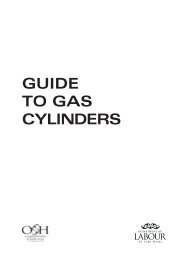Temperature in Places of Work - Health and Safety - Department of ...
Temperature in Places of Work - Health and Safety - Department of ...
Temperature in Places of Work - Health and Safety - Department of ...
Create successful ePaper yourself
Turn your PDF publications into a flip-book with our unique Google optimized e-Paper software.
TEMPERATURE <strong>in</strong> places <strong>of</strong> work<br />
Methods <strong>of</strong> <strong>in</strong>vestigat<strong>in</strong>g<br />
Thermal problems<br />
Us<strong>in</strong>g a thermometer to assess heat <strong>and</strong> cold<br />
Before spend<strong>in</strong>g a lot <strong>of</strong> money on control options, it’s worth<br />
gett<strong>in</strong>g some <strong>in</strong>formation on the thermal environment. In<br />
particular, it’s worth know<strong>in</strong>g:<br />
• What are the hottest or coolest parts <strong>of</strong> the day?<br />
• What are the maximum or m<strong>in</strong>imum temperatures?<br />
• What is the average maximum or m<strong>in</strong>imum temperature?<br />
• How <strong>of</strong>ten the average is exceeded?<br />
Another way <strong>of</strong> look<strong>in</strong>g at this <strong>in</strong>formation is to work out<br />
how much <strong>of</strong> the time a particular temperature is exceeded,<br />
expressed as a percentage. Look at the 90, 10, 5 <strong>and</strong> 1<br />
percentage levels.<br />
• Is there a pattern as to what temperature people feel<br />
discomfort at?<br />
• You can also compare your read<strong>in</strong>gs with the daily weather<br />
high. How does your maximum read<strong>in</strong>g compare?<br />
Set up a thermometer <strong>in</strong> the area you want to measure, but<br />
place it out <strong>of</strong> direct sunlight <strong>and</strong> away from a radiant heat<br />
source. Choose a period <strong>of</strong> time you want to take read<strong>in</strong>gs at.<br />
They can be hourly, two-hourly or over a particular part <strong>of</strong> the<br />
day only. Write them down for future reference.<br />
If your workplace has a computer with spreadsheet s<strong>of</strong>tware, you<br />
can make a up a spreadsheet <strong>of</strong> your temperature read<strong>in</strong>gs.<br />
From this, you can work out the seasonal average for each time<br />
<strong>of</strong> day read<strong>in</strong>gs are taken.<br />
A more detailed survey would also <strong>in</strong>clude read<strong>in</strong>gs for humidity,<br />
radiant heat <strong>and</strong> air speed.<br />
Observ<strong>in</strong>g thermal <strong>in</strong>fluences <strong>in</strong> your workplace<br />
Look at the six ma<strong>in</strong> heat <strong>in</strong>fluences on Sheet 2: Factors that<br />
Affect How Hot or Cold We Feel. What can you see <strong>in</strong> your<br />
workplace that would add or subtract to the air temperature<br />
from them? The follow<strong>in</strong>g checklist may help.<br />
Humidity<br />
• Does any part <strong>of</strong> your work process create steam or moisture<br />
(e.g. a kitchen or laundry)?<br />
ISSUED BY THE OCCUPATIONAL SAFETY AND HEALTH SERVICE, DEPARTMENT OF LABOUR, WELLINGTON, NEW ZEALAND<br />
3730GFO DECEMBER 1997<br />
OCCUPATIONAL SAFETY<br />
& HEALTH SERVICE<br />
DEPARTMENT OF<br />
LABOUR<br />
TE TARI MAHI<br />
Information Sheet No. 8<br />
Cont<strong>in</strong>ued over





